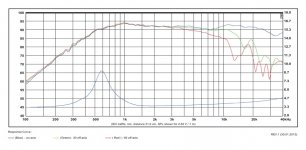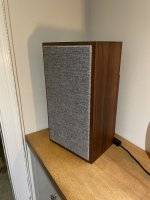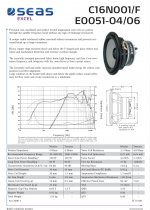That does make a lot of sense. I assume you mean USD, the cheapest I can find here is over $250, which is far more than I have put into the speakers :-(You can't build a crossover without a measurement microphone.
Manufacture spec sheets are completely useless for modelling.
A umik1 is $80, it will last a lifetime, be all the mic even the most advanced hobbyist will ever need and be useful regardless of DIY intentions for room correction.
I can promise, that if you built any of your designs from modelled specs and manufacture datasheets, and then measured it, it will be WILDLY different.
I can see that you've put a lot of time ino the project, and don't want to disparage you, what I want is for you to be happy and confident with the end result, and save you some money on cycling through endless passive components trying to blindly get something that sounds "right"
The response attached, is what happens if you model a pair of the very highly regarded jeff bagby adelphos speakers using the manufacturers specs, and that's using super high quality and linear drivers known to be very consistent with their published parameters. Your results are likely to be exponentially worse.
This is what the author of Vituixcad has to say about the UMIK-1

I'm quite ready to change license agreement so that Umik-1 users won't have permission to use VituixCAD.
And you say it uses factory response data? This is from SB Acoustics site for the TW29R...I'm not sure you do remember this exact comparison as it's one I did myself and haven't posted about on here 😂

What is the reasoning behind Kimmo's announcement he was ready to not permit Umik 1 owners using Vituixcad?
I have not followed threads thoroughly.
I have not followed threads thoroughly.
Radiators introduce variable delay which depends on off-axis angle so Umik-1 owners need REW (not e.g. ARTA) and acoustical reference signal in order to lock timing and prevent measurement program to normalize = damage timing with it's own logic by moving impulse peak close to 0 ms. Timing locked to known mechanical reference point = rotation center while off-axis measurement sequence is required to get correct acoustical sum of different drivers while simulating crossover of multi-way design. Typical Umik-1 owner visiting in VituixCAD thread does not have HF radiator installed to mic boom for acoustical reference, and no idea what it is and why. They are just dead weight in the boat for other community. In addition, acoustical reference is not very simple add-in because REW normalizes IR to reference. User still have to remove some flying time: difference between distance from common mechanical reference point on the baffle to mic and distance from acoustical reference radiator to mic. User manual says that Umik-1 is banned so it should be simple enough.What is the reasoning behind Kimmo's announcement he was ready to not permit Umik 1 owners using Vituixcad?
Ease of entry allows new people to get things wrong more frequently.What is the reasoning behind Kimmo's announcement he was ready to not permit Umik 1 owners using Vituixcad?
I have not followed threads thoroughly.
It's still a perfectly capable microphone, Allen cut the quote from him short where it goes on to blame the users, not the product. It can be used with arta or any other measurement program, it's just a calibrated microphone with a usb pre-amp built in.
Problem is in the product, but of course beginners can't see it with layman intuition. I don't blame them, but reading VCAD's measurement instructions for REW and ARTA in early phase should give clear information that USB mics should be ignored for good....it goes on to blame the users, not the product. It can be used with arta or any other measurement program, it's just a calibrated microphone with a usb pre-amp built in.
I have also suggested to miniDSP's tech support that they should design mic with two channel I/O, loop reference channel inside the mic and add signal output. That would also decrease total cost compared to external sound card for output only (existing price of Umik with external sound card is higher than cheaper calibrated mic and external 2ch sound card). Reply was proposal to add acoustical reference to VCAD proving they don't (want to) understand that the problem is their microphone. Local dealers and "specialists" continue to hide this issue and recommend product though problem was documented more than six years ago and discussed on several forums dozens of times. And still continues...
That's a great suggestion for how to bring Umiks up to dual channel. Bummer it didn't meet enthusiasm.Problem is in the product, but of course beginners can't see it with layman intuition. I don't blame them, but reading VCAD's measurement instructions for REW and ARTA in early phase should give clear information that USB mics should be ignored for good.
I have also suggested to miniDSP's tech support that they should design mic with two channel I/O, loop reference channel inside the mic and add signal output. That would also decrease total cost compared to external sound card for output only (existing price of Umik with external sound card is higher than cheaper calibrated mic and external 2ch sound card). Reply was proposal to add acoustical reference to VCAD proving they don't (want to) understand that the problem is their microphone. Local dealers and "specialists" continue to hide this issue and recommend product though problem was documented more than six years ago and discussed on several forums dozens of times. And still continues...
I think if anyone stays with learning measurements and tuning speakers long enough, they inevitably learn the shortcomings of acoustic reference timing, and move on to dual channel loopback.
Back on topic, of course my simulated XO will be imperfect compared to having real measurements.
But let's get real, these speakers are what 20-30yrs old, and the owner has swapped in a different woofer from another speaker, didn't like the sound of the original XO (which used 1st order on bass around 2k, 2nd order highpass around 2k on mid with no low-pass at all, and 2nd order electrical around 7k on tweeter with no tweeter attenuation). The Seas datasheet measurements were taken in a 28L box. I applied the diffraction anyway to the mid and tweeter from Jeff's Diffraction spreadsheet, and used XO points of 700hz (recommended by Vifa for the mid and well under beaming range for an 8" woofer) and 3500hz (2 x FS for the D19 tweeter, and before off-axis drops too much the mid). I chose LR2-LR2 bass mid to reduce parts cost, and LR4-LR4 cause that tweeter is difficult to work with for any other slope.
Remember also the swapped in woofer is the one used in the Dynaco A25, which we know is used with no low-pass at all, relying on its unusual natural roll-off. You could say it's not the best choice to mate with a mid at all, unless you want to run that mid only from 2k, and it seems weird nowadays to run a 4" mid to 7khz.
Anyway, I'm not saying it's going to be ruler flat, but I think it has a higher chance of sounding better than what it is doing right now.
If this is just coming down to parts cost on 1 coil, well here are all the files. See what can be done with this strange woofer. Have at it.
FWIW, I did the same steps (datasheet inputs applying diffraction) against Jeff Bagby's fully documented Sopranos (SB12 + SB26TCN) - it didn't come out completely horrible. Taken from 200hz (below which the filter does nothing).


But let's get real, these speakers are what 20-30yrs old, and the owner has swapped in a different woofer from another speaker, didn't like the sound of the original XO (which used 1st order on bass around 2k, 2nd order highpass around 2k on mid with no low-pass at all, and 2nd order electrical around 7k on tweeter with no tweeter attenuation). The Seas datasheet measurements were taken in a 28L box. I applied the diffraction anyway to the mid and tweeter from Jeff's Diffraction spreadsheet, and used XO points of 700hz (recommended by Vifa for the mid and well under beaming range for an 8" woofer) and 3500hz (2 x FS for the D19 tweeter, and before off-axis drops too much the mid). I chose LR2-LR2 bass mid to reduce parts cost, and LR4-LR4 cause that tweeter is difficult to work with for any other slope.
Remember also the swapped in woofer is the one used in the Dynaco A25, which we know is used with no low-pass at all, relying on its unusual natural roll-off. You could say it's not the best choice to mate with a mid at all, unless you want to run that mid only from 2k, and it seems weird nowadays to run a 4" mid to 7khz.
Anyway, I'm not saying it's going to be ruler flat, but I think it has a higher chance of sounding better than what it is doing right now.
If this is just coming down to parts cost on 1 coil, well here are all the files. See what can be done with this strange woofer. Have at it.
FWIW, I did the same steps (datasheet inputs applying diffraction) against Jeff Bagby's fully documented Sopranos (SB12 + SB26TCN) - it didn't come out completely horrible. Taken from 200hz (below which the filter does nothing).
Attachments
A definite "YES"n to the above post.
It's an old pigs ear and no amount of polishing it will turn it into a silk purse; so a near enough good enough XO should be adequate.
What is important is that it sounds good to the maker.
I'd be doing it differently, and crossing wider with the midrange; but that is me
It's an old pigs ear and no amount of polishing it will turn it into a silk purse; so a near enough good enough XO should be adequate.
What is important is that it sounds good to the maker.
I'd be doing it differently, and crossing wider with the midrange; but that is me
Thanks @Moondog55 - yeah I have no experience with any of these drivers, and have no idea what the current speaker sounds like. Just the Vifa datasheet recommended to use 12db slopes with it from 700hz. The upper end response of the K10 is also kind of shocking from 3k - it seems to fall off a cliff. Bottom line, It doesn't seem easy to get any kind of normal summing slopes with this group of drivers; not to say they can't be forced to.
I've no direct experience with that Vifa 4" but I've used similar cheap mids and I think you need to use much steeper slopes to get it clean down to around 500.
Whether that is worth doing is up to the individual but using a bigger midrange compartment seems to help me when doing stuff like this and that shorts the woofer of working volume. I Prefer first and second order crossovers and if I have to go steeper I use electronic or digital now
Behringer CX units are so cheap it seems silly not to go that way
Whether that is worth doing is up to the individual but using a bigger midrange compartment seems to help me when doing stuff like this and that shorts the woofer of working volume. I Prefer first and second order crossovers and if I have to go steeper I use electronic or digital now
Behringer CX units are so cheap it seems silly not to go that way
For both you and moondog I sincerely appreciate your inputs. It’s not being put off for the cost of one coil, and this has been a valuable trip down memory lane. I built many pairs of speakers back in the eighties whilst in uni to make some spare cash, including hand winding the inductors, and I’m now remembering plus learning some more. I wanted to experiment with the crossovers I already have, to see what could be done. To build the new ones per the design I need to order parts from three different suppliers, which will take weeks to arrive and then I have to fabricate them. In the meantime I have finished the cabinet restoration and am enjoying listening to them…A definite "YES"n to the above post.
It's an old pigs ear and no amount of polishing it will turn it into a silk purse; so a near enough good enough XO should be adequate.
What is important is that it sounds good to the maker.
I'd be doing it differently, and crossing wider with the midrange; but that is me
Attachments
Rekindling this old thread….would you believe it, I found another set of these SSU-280 speakers, this time with good cabinets but only one original woofer. I bought them (for $20) to use the tweeters/mids as spares and when I picked them up the owner said he still had the other woofer. I took it home and tested it, it still works but the foam is gone.
So, the question now is how to identify this woofer - it’s a Peerless also made in Denmark - and where to source a refoaming kit!





So, the question now is how to identify this woofer - it’s a Peerless also made in Denmark - and where to source a refoaming kit!
- Home
- Loudspeakers
- Multi-Way
- Interdyn and SEAS drivers and crossover combination


